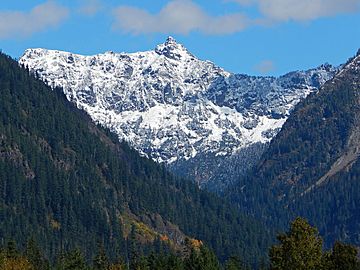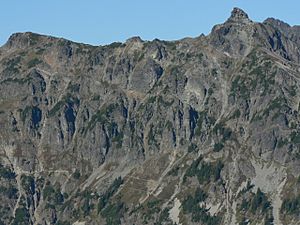Chikamin Peak facts for kids
Quick facts for kids Chikamin Peak |
|
|---|---|

The southwest aspect of Chikamin Peak seen from Interstate 90 at Hyak
|
|
| Highest point | |
| Elevation | 7,000 ft (2,100 m) |
| Prominence | 1,080 ft (330 m) |
| Isolation | 1.36 mi (2.19 km) |
| Parent peak | Lemah Mountain (7,500 ft) |
| Geography | |
| Location | Kittitas County, Washington state, U.S. |
| Parent range | Cascade Range |
| Climbing | |
| First ascent | May 30, 1915 by C.G. Morrison and I.J. Kohler |
| Easiest route | Scrambling |
Chikamin Peak is a mountain in Washington state. It stands about 7,000+ ft (2,130+ m) tall. This peak is part of the Cascade Range in Kittitas County.
Chikamin Peak is located within the Alpine Lakes Wilderness. This area is managed by the Okanogan-Wenatchee National Forest. The mountain's name, "Chikamin," comes from Chinook Jargon. This old language word means "money" or "metal." Edmond S. Meany, who was president of The Mountaineers club, suggested the name. The U.S. Board on Geographic Names officially adopted it in 1916.
Chikamin Peak is the highest point on Chikamin Ridge. This ridge is about 6 mi (9.7 km) northeast of Snoqualmie Pass. Other important peaks on Chikamin Ridge include Four Brothers and Three Queens. Water from the mountain flows into streams that feed the Yakima River. The Pacific Crest Trail runs along the southwest side of Chikamin Ridge. From the trail, you can scramble up a steep path to reach the summit.
Contents
Mountain Weather
Chikamin Peak is in a "marine west coast" climate zone. This means it gets a lot of weather from the Pacific Ocean. Most weather systems move northeast towards the Cascade Mountains.
How Mountains Affect Weather
When air from the ocean hits the tall Cascade Mountains, it is forced to rise. As the air goes higher, it cools down. This causes the moisture in the air to turn into rain or snowfall. This process is called orographic lift. Because of this, the western side of the Cascades gets a lot of rain and snow. This is especially true during the winter months.
Seasonal Weather Patterns
In winter, the weather is often cloudy. However, during summer, high-pressure systems over the Pacific Ocean become stronger. This often leads to clear skies and sunshine. The ocean's influence means that snow in this area tends to be wet and heavy. This type of snow can increase the risk of avalanches, where large amounts of snow slide down the mountain.
Mountain Formation
The Alpine Lakes Wilderness has very rugged land. You can see jagged peaks, long ridges, deep valleys carved by glaciers, and tall granite walls. There are also more than 700 mountain lakes.
Geological History
Many years ago, big geological events shaped this area. These events created the varied landscape and huge changes in elevation across the Cascade Range. These elevation changes also lead to different climates and types of plants. The land here ranges from about 1,000 feet (300 m) in lower areas to over 9,000 feet (2,700 m) on Mount Stuart.
The Cascade Mountains started forming millions of years ago. This was during the late Eocene Epoch. At that time, the North American Plate (a huge piece of Earth's crust) was moving over the Pacific Plate. This movement caused many volcanic eruptions. Also, smaller pieces of Earth's crust, called terranes, helped create the North Cascades about 50 million years ago.
The Power of Glaciers
During the Pleistocene period, which was over two million years ago, huge sheets of ice called glaciers moved across the land. These glaciers advanced and then melted back many times. As they moved, they scraped and shaped the landscape, leaving behind rock debris. The last time glaciers melted away from the Alpine Lakes area was about 14,000 years ago. By 10,000 years ago, they had moved north of the Canada–US border.
The valleys in this area have a "U"-shape. This shape was created by these recent glaciers. The combination of land uplift (when land rises) and faulting (when cracks form in the Earth's crust) along with glaciation has created the tall peaks and deep valleys you see in the Alpine Lakes Wilderness today.




